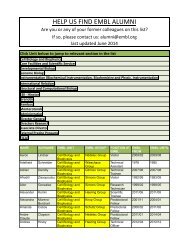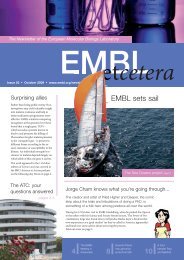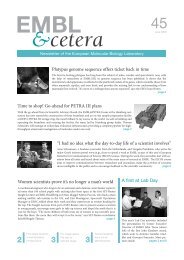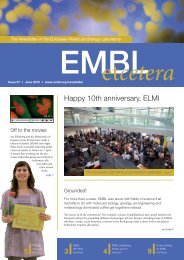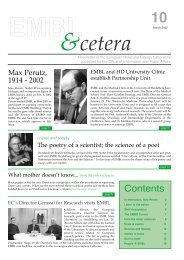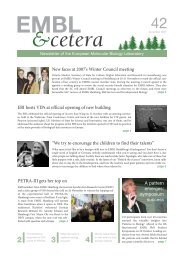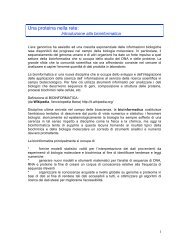ayout 1 - EMBL Grenoble
ayout 1 - EMBL Grenoble
ayout 1 - EMBL Grenoble
You also want an ePaper? Increase the reach of your titles
YUMPU automatically turns print PDFs into web optimized ePapers that Google loves.
Structural and Computational Biology UnitFunctional mechanisms of complex enzymes intranscription regulation and anti-cancer drugsPrevious and current researchWe study the structure and dynamics of biomolecular complexes and catalytic RNAs in solutionby nuclear magnetic resonance (NMR) spectroscopy in combination with a wide range of biochemicaland biophysical techniques. Recent advances in the NMR methodology and instrumentationhave allowed overcoming traditional size limitations and have made NMR a very powerfultechnique, in particular for the investigation of highly dynamic, partially inhomogeneous moleculesand complexes.The laboratory focuses on studying: 1) The interaction of small drugs with cellular receptors; and2) Structure-activity and dynamics-activity relationship of RNP complexes and catalytic RNAs involvedin RNA processing.Conformational switches occur in macromolecular receptors at all cellular levels in dependenceof the presence of small organic molecules, which are able to trigger or inhibit specific cellularprocesses. We develop both computational and experimental tools to access the structure of largereceptors in complex with function regulators. In particular we study the functional mechanismsof anti-cancer drug-leads, designed as inhibitors of kinases, proteasome and tubulin.A second aim of our work is to describe the features of RNA-protein recognition in RNP complexenzymes and to characterise the structural basis for their function. Recently, we have determinedthe three-dimensional architecture of the ternary complex between the 15.5 kDa protein/U4 RNAand the hPrp31 protein, which is a constituent of the U4/U6 particle in the spliceosome (in collaboration with M. Wahl and R. Lührmann atthe MPI, Göttingen; see figure). Currently, we are investigating the nucleolar multimeric box C/D RNP complex responsible for the methylationof the 2’-OH position in rRNA. 2’-O-methylation is one of the most relevant modifications of newly transcribed RNA as it occursaround functional regions of the ribosome. This suggests that 2’-O-methylation may be necessary for proper folding and structural stabilisationof rRNA in vivo. In another project, we collaborate with the group of Ramesh Pillai (page 95) at <strong>EMBL</strong> <strong>Grenoble</strong> to understand the structureof RNP complexes involved in the regulation of gene expression through small non-coding RNAs.Future projects and goalsWe use NMR spectroscopy to study how proteins and nucleic acids interact with eachother and the structural basis for the activity of complex enzymes. In addition we dedicateour efforts to understand the activity of small-molecule inhibitors of cellular targetsrelevant in anti-cancer therapy. We use innovative NMR techniques to access thestructure of large, dynamic multi-component complexes in combination with otherstructural biology techniques (SANS, X-ray and EM) and biochemical data. Our philosophyis to combine high-resolution structures of single-components of the complexeswith both structural descriptors of the intermolecular interactions in solutionand computational methods, to obtain an accurate picture of the molecular basis ofcellular processes.NMR-based docking model of the spliceosomal U4-RNA/15.5kD/hPrp31 complex,showing that the Nop-domain of the hPrp31 (green) recognises a composite platformformed by the U4 RNA stem II (pink) and by the 15.5K protein (blue). This complexfold is novel and classifies the Nop-domain as a genuine RNP recognition motif.TeresaCarlomagnoPhD 1996, University ofNaples Federico II.Postdoctoral research atFrankfurt University andScripps Research Institute.Group leader at the MPI forBiophysical Chemistry,Göttingen, 2002-2007.Group leader at <strong>EMBL</strong> since2007. Joint appointment withthe Gene Expression Unit.Selected referencesKirkpatrick, J.P., Li, P. & Carlomagno, T. (2009). Probing mutationinducedstructural perturbations by refinement against residualdipolar couplings: application to the U spliceosomal RNP complex.Chembiochem., in pressLi, P., Kirkpatrick, J. & Carlomagno, T. (2009). An efficient strategyfor the determination of the 3D architecture of ribonucleoproteincomplexes by the combination of a few easily accessible NMR andbiochemical data: intermolecular recognition in a U spliceosomalcomplex. J. Mol Biol., in pressOrts, J., Tuma, J., Reese, M., Grimm, S.K., Monecke, P., Bartoschek,S., Schiffer, A., Wendt, K.U., Griesinger, C. & Carlomagno, T. (2008).Crystallography-independent determination of ligand binding modes.Angew Chem. Int. Ed. Engl., 7, 7736-0Liu, S., Li, P., Dybkov, O., Nottrott, S. et al. (2007). Binding of thehuman Prp31 Nop domain to a composite RNA-protein platform inU snRNP. Science, 316, 115-20Reese, M., Sanchez-Pedregal, V.M., Kubicek, K., Meiler, J. et al.(2007). Structural basis of the activity of the microtubule-stabilizingagent epothilone A studied by NMR spectroscopy in solution.Angew Chem. Int. Ed. Engl., 6, 186-85



